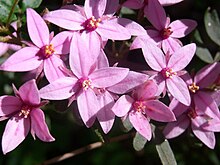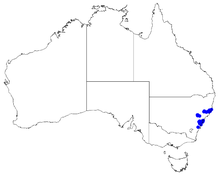
Boronia pinnata is a plant in the citrus family, Rutaceae, and is endemic to New South Wales. It is an erect, woody shrub with pinnate leaves and groups of between three and forty pink flowers arranged in leaf axils. It flowers in spring and early summer and is found in coastal areas between Ballina and Jervis Bay.

Boronia fraseri, commonly known as Fraser's boronia, is a plant in the citrus family occurring near Sydney in Australia. It is an erect, multi-branched shrub with pinnate leaves and pink flowers arranged in small groups in the leaf axils.

Cyanothamnus anemonifolius, commonly known as narrow-leaved boronia or sticky boronia, is a flowering plant that is endemic to south-eastern Australia. It is a shrub with mostly pinnate leaves, with white to pale pink four-petalled flowers in leaf axils.

Cyanothamnus nanus, commonly known as the dwarf boronia or small boronia is a plant in the citrus family Rutaceae and is endemic to eastern Australia. It is a prostrate or low spreading shrub with simple or three-part leaves and white or pale pink four-petalled flowers.
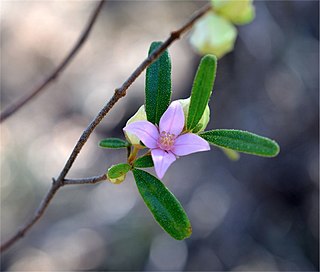
Boronia duiganiae is a plant in the citrus family Rutaceae and is endemic to mountain ranges in south-east Queensland, Australia. It is an erect shrub with many branches, leaves with one, three or five leaflets, and pink to white, four-petalled flowers.
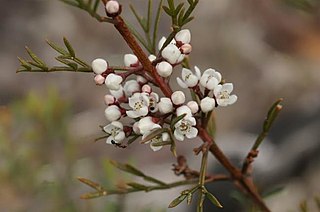
Cyanothamnus occidentalis, commonly known as the rock boronia, is a plant in the citrus family Rutaceae and is endemic to eastern Australia. It is an erect, woody shrub with pinnate or bipinnate leaves and groups of up to three white to pale pink, pink four-petalled flowers arranged in leaf axils.

Boronia subulifolia is a plant in the citrus family Rutaceae and is endemic to a small area in south-eastern New South Wales in Australia. It is an erect, woody shrub with pinnate leaves with mostly linear leaflets, and light to deep pink, four-petalled flowers in the leaf axils or on the ends of the branches.
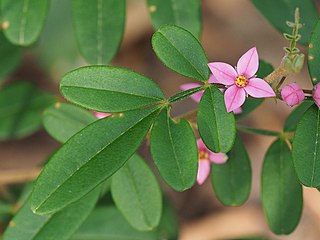
Boronia umbellata, commonly known as the Orara boronia, is a plant in the citrus family Rutaceae and is endemic to a small area on the north coast of New South Wales. It is an erect shrub with many branches, aromatic, pinnate leaves and clusters of up to ten dark pink flowers in the leaf axils.
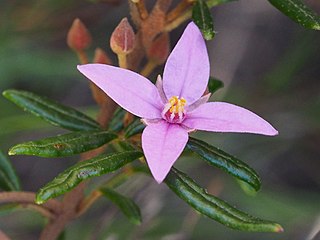
Boronia angustisepala is a plant in the citrus family Rutaceae and is endemic to New South Wales, Australia. It is an erect shrub with many branches, pinnate leaves with up to eleven leaflets, and bright pink, four-petalled flowers.
Boronia citrata, commonly known as lemon boronia, is a plant in the citrus family, Rutaceae and is endemic to Victoria. It is an erect, woody shrub with pinnate, strongly lemon-scented leaves and pale pink to rosy pink, four-petalled flowers arranged in groups of up to five.

Boronia hapalophylla is a plant in the citrus family Rutaceae and is endemic to New South Wales. It is an erect or straggling shrub with simple leaves, hairy branches and relatively large pink, four-petalled flowers.
Boronia hoipolloi is a plant in the citrus family Rutaceae and is endemic to a small area in Queensland. It is an erect or pendulous shrub with pinnate leaves and pink, four-petalled flowers. It is only known from a few collections near Mount Isa.
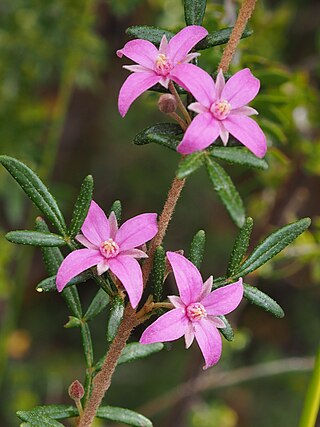
Cyanothamnus inflexus is a plant in the citrus family Rutaceae and is endemic to tablelands near the New South Wales - Queensland border in Australia. It is an erect, woody shrub with pinnate leaves and up to seven white to pink four-petalled flowers in the leaf axils. Boronia bipinnata is similar but has larger, bipinnate or tripinnate leaves and smaller sepals and petals.
Boronia interrex, commonly known as the Regent River boronia, is a plant in the citrus family, Rutaceae and is endemic to a small area in the Kimberley region of Western Australia. It is an erect, sometimes low-lying shrub with pinnate leaves, cream-coloured to pale pink sepals and pink petals, the sepals longer and wider than the petals.
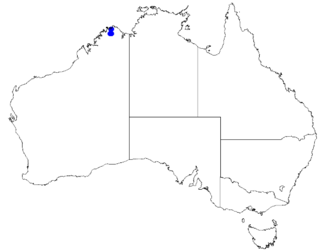
Boronia kalumburuensis is a plant in the citrus family Rutaceae and is endemic to the Kalumburu area of Western Australia. It is an erect or sprawling shrub with many branches, pinnate leaves and white to pink four-petalled flowers with the sepals longer and wider than the petals.
Boronia minutipinna is a plant in the citrus family Rutaceae and is endemic to a small area in the Kimberley region of Western Australia. It is an erect shrub with many branches, hairy stems and leaves, pinnate leaves and white to pink, four-petalled flowers with the sepals longer and wider than the petals.
Cyanothamnus montimulliganensis is a plant in the citrus family Rutaceae and is endemic to a single mountain in Queensland. It is an erect, woody shrub with pinnate or bipinnate leaves and white, four-petalled flowers usually arranged singly in leaf axils.
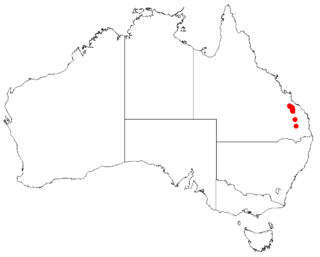
Boronia palasepala is a plant in the citrus family Rutaceae and is endemic to a small part of Queensland, Australia. It is an erect, rounded shrub with many branches, simple leaves and pink to white, four-petalled flowers.
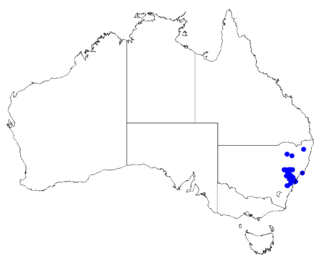
Boronia rubiginosa is a plant in the citrus family Rutaceae and is endemic to New South Wales in Australia. It is a shrub with pinnate leaves that are paler on the lower surface, and up to three pale to bright pink, four-petalled flowers in the leaf axils.

Boronia stricta is a plant in the citrus family, Rutaceae and is endemic to near-coastal areas of the south-west of Western Australia. It is a slender shrub with often crowded pinnate leaves with linear leaflets, and pink, four-petalled flowers borne singly or in groups of two or three in leaf axils.
